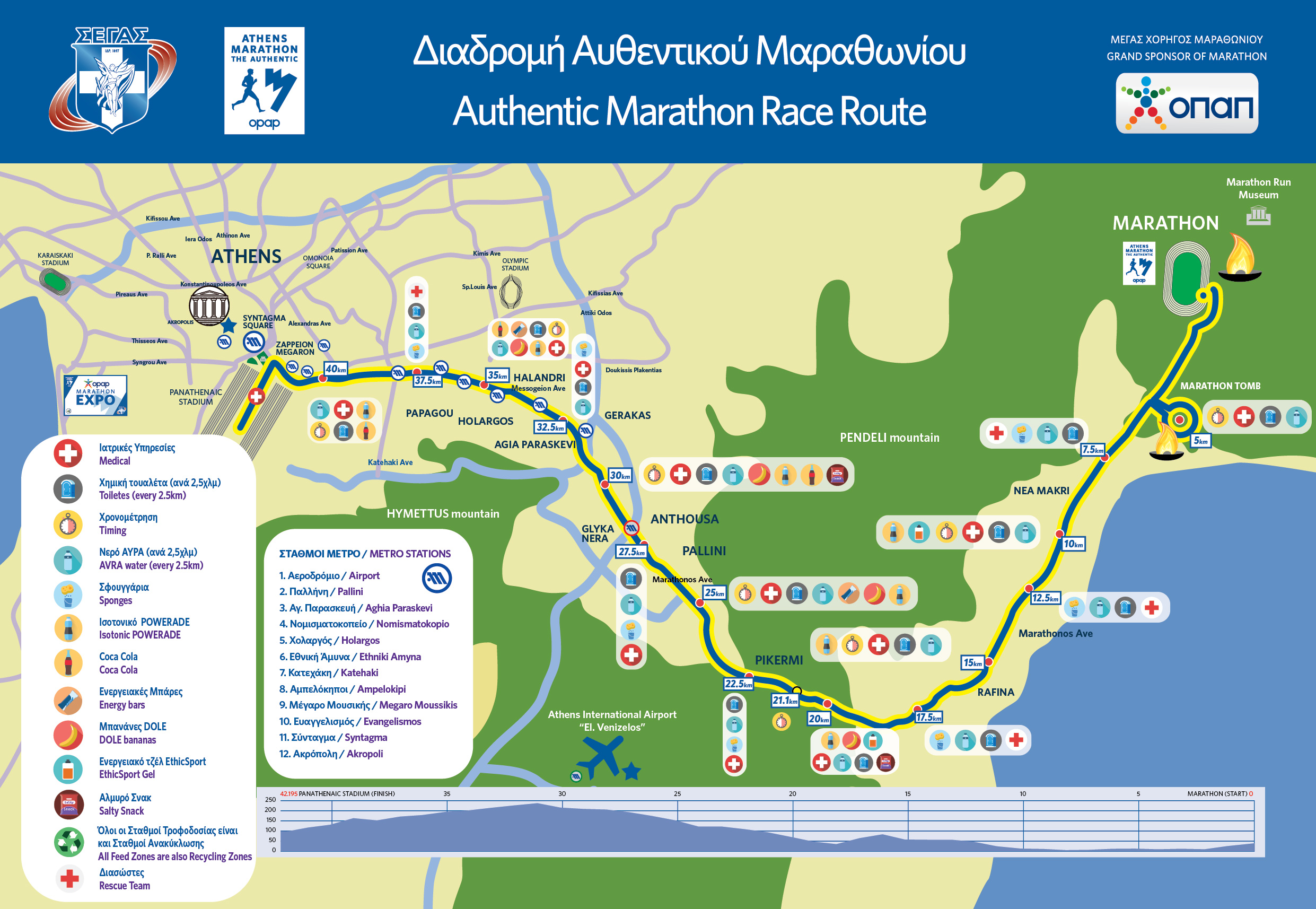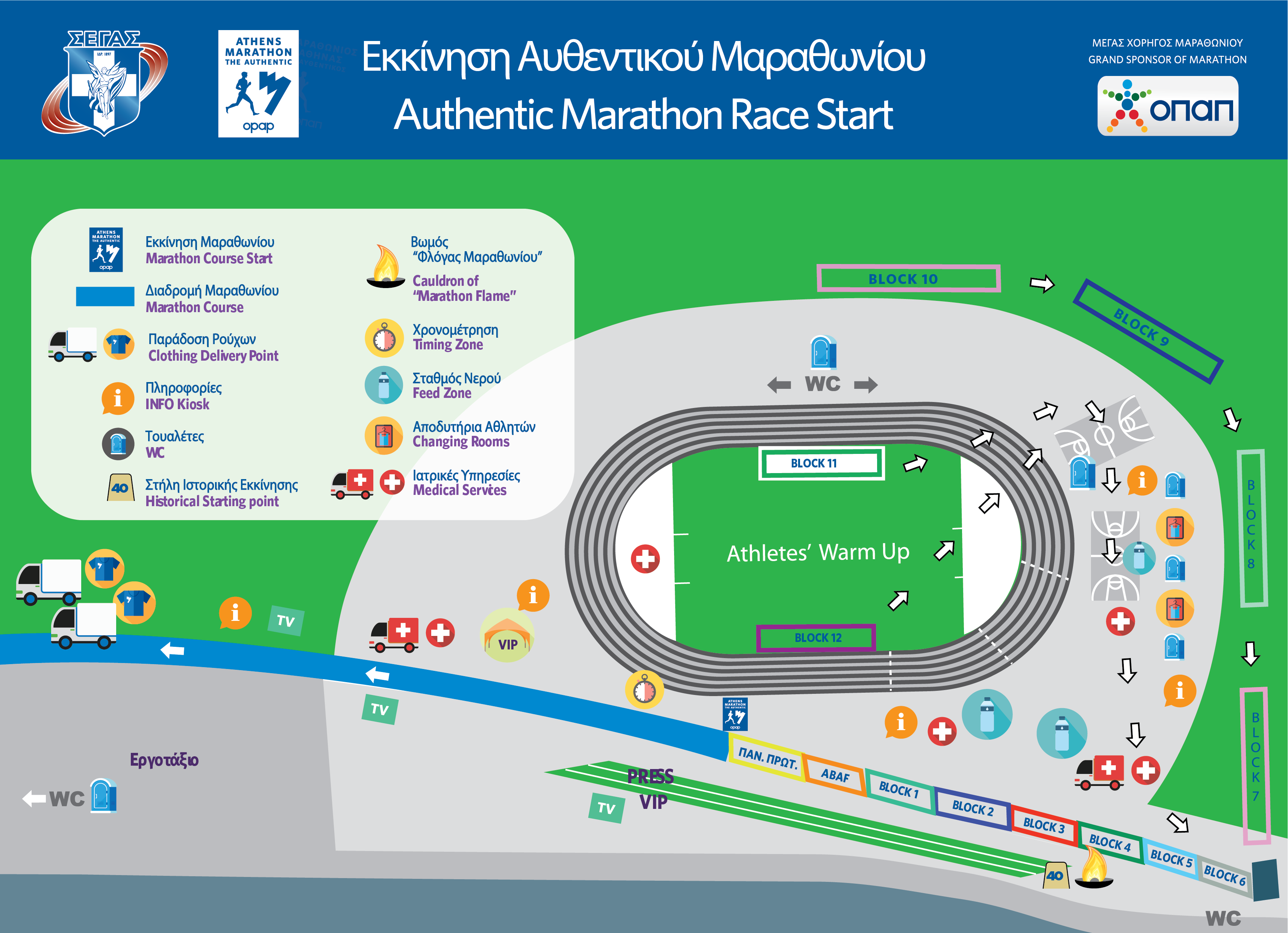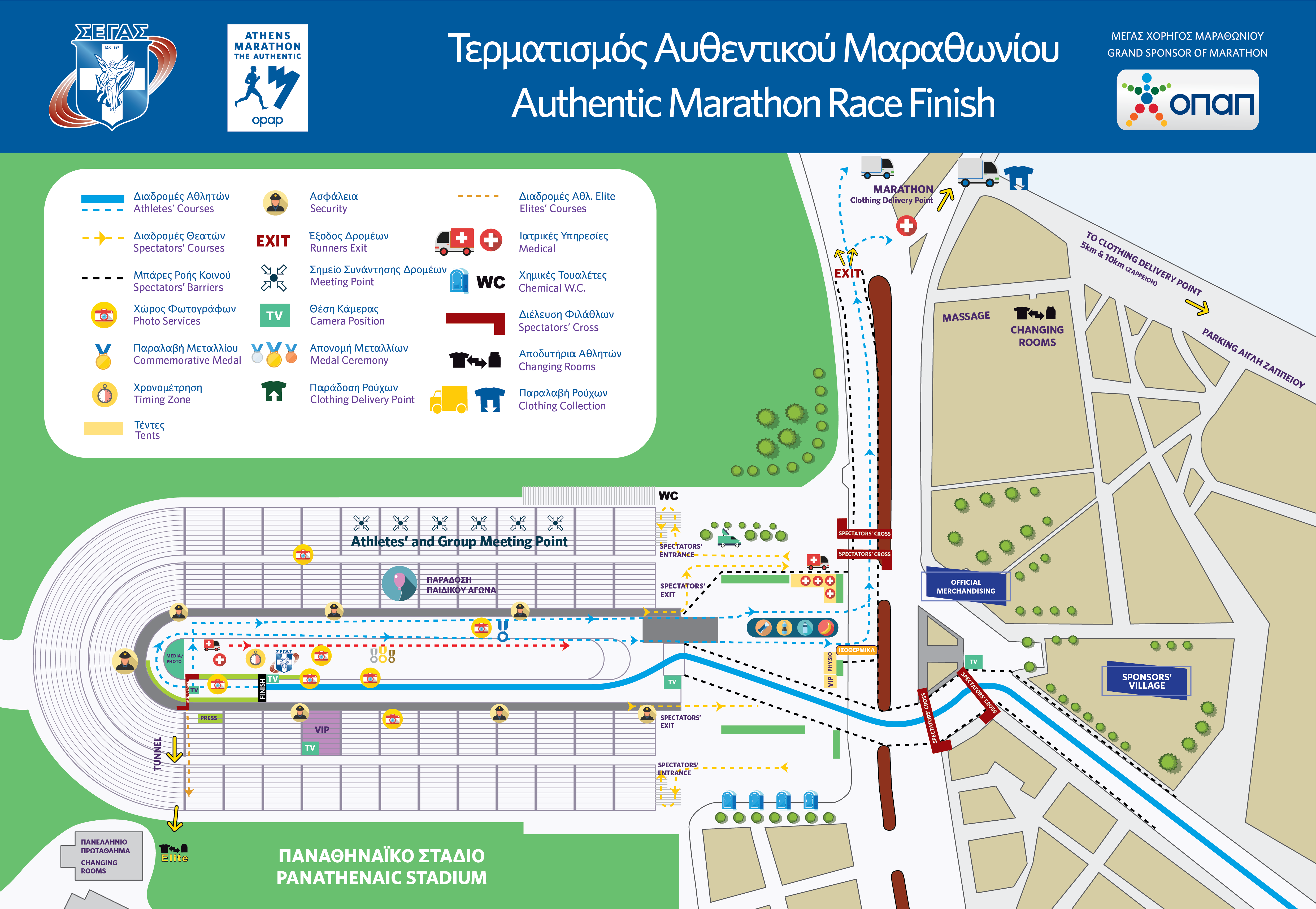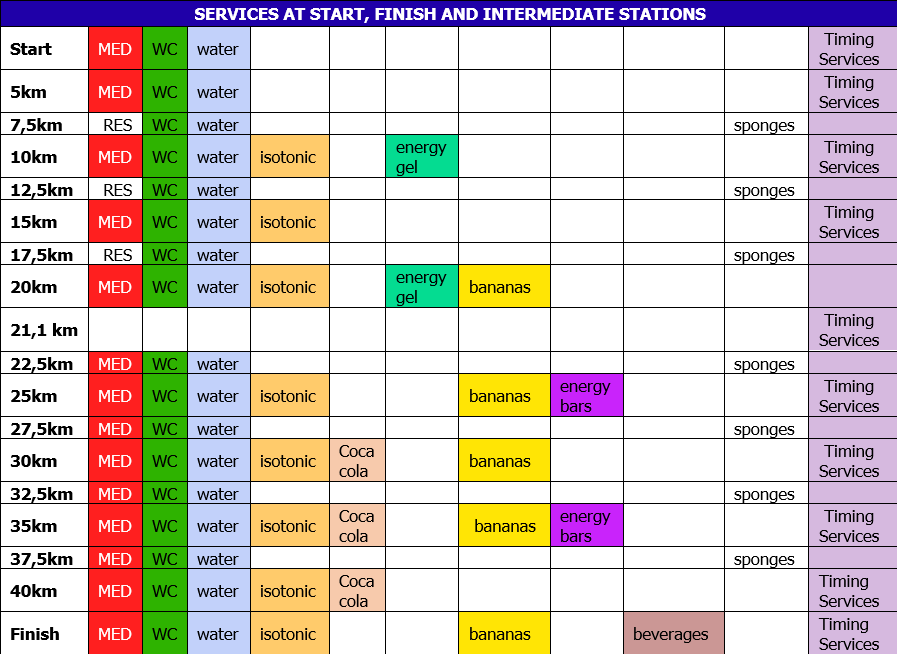Contents
General Information
- The Marathon Race is open to participants 18 years old (born in 2006) or older. The age of the runners is calculated from the year of birth (not the calendar year).
- The Marathon Road Race will start at 9.00am.
- A time limit of eight (8) hours has been set for completion of the Marathon.
- All finishes will be completed by 17:42′ including the time delay of all consecutive starts.
- All runners participate in the race AT THEIR OWN RISK. The organizers are not responsible for any issues concerning the health of the participants due to lack of preventive medical check-ups. It is recommended that participants have undergone a recent medical examination before participating in the race. Particular attention should be paid by people who are experiencing any form of heart problems. It is also recommended that all participants, regardless of age, have a full cardiac check up before participating in the race. The organizers will not ask for medical certificates from any athlete, as all participants compete at their own risk.
Before the Race
A.Transportation of Runners to the Starting Point
- Participants will be transported to the starting area by buses from six (6) different points in central Athens.
- Departure time: from 05:30′ to 06:45′.
- After 06:45′ it is not possible to transport participants using means of the event’s Organizing Committee. Attention: the last bus will leave from Syngrou-Fix station at 06:15.
- The transportation is direct and without intermediate stops.
Boarding points
- Metro stop Line 2 “Syngrou-Fix”, along Syngrou Avenue, boarding from the ascending side (exit “Syngrou”). Attention: The last bus will leave from Syngrou-Fix station at 06:15.
- Metro stop Line 2 3 “Syntagma”
a) along Vasilissis Amalias Avenue from the side of the Hellenic Parliament/ Monument of the Unknown Soldier)
b) along the length of Georgiou Avenue in front of the Grande Bretagne hotel. - Metro stop Line 2 “Panepistimio”, along Panepistimiou Avenue on the side of the University.
- Metro stop Line 3 “Evangelismos“, along Vasilissis Sofias Avenue on the ascending side.
- Metro stop Metro Line 3 “Katehaki“, along Mesogeion Avenue from the ascending side towards Ag. Paraskevi.
- Metro/Train stop “Omonia”, along Panepistimiou Avenue and 3 Septemvriou Avenue on Omonia Square.
In order to spread the number of runners at the various boarding points and to better manage the means of transport, it is suggested that runners use all boarding stations.
ATTENTION: In order to avoid inconvenience, the Organizing Committee of the event recommends runners not use their own means of transport to the Starting Point.
Runners who choose to travel to the starting point using their own means must:
(a) be at the venue (starting area/ Marathon) at least one hour before the start time of the race, i.e. by 08:00′ at the latest, taking into account the distance that the runners will have to walk from the drop-off parking to the starting area (approximately 800m).
(b) take into account that on the route of the Marathon there will be a traffic ban in both directions of Marathonos Avenue starting at 08:00′.
Β. Disembarkation at the Starting Area - Clothing Management
- After disembarking from the buses and after receiving the special nylon poncho from the volunteers of the organization, they must proceed immediately to the starting area.
- Runners are advised to deliver their clothing bag directly to the respective transport vehicles according to their bib number.
Clothing Bags
- The clothing bag is collected together with the bib number and the corresponding sticker number from the Runners’ Center & Marathon EXPO.
- The sticker with the runner’s bib number must be placed on the bag in a way that it is clearly visible, making it easier for volunteers to return it after the finish.
- Runners must place their required personal belongings and clothing inside. Ideally it should contain only clothing. It must not contain travel documents, money, valuables or medicines. SEGAS and the Organizing Committee of the event do not bear any responsibility in case of loss of objects of value.
- The Organizing Committee does not accept any other backpacks, bags etc., except for the special bags that it provides to the runners.
- The bag must be delivered no later than 40 minutes before the first start of the Marathon i.e. by 08:20′
- The bag drop-off will be made to the clothing transport vehicles based on the bib number of each runner. Each vehicle will have a sign on it describing the range of bib numbers.
- The clothing transport vehicles will be located 150 meters in front of the Start Arch (after the start line), to transport the equipment to the finish line.
- After the finish, bags can be picked up by showing the bib number at a predetermined location that will be announced soon.
Attention: Bags that are not properly collected after the end of the race will be collected and stored at the Marathon Office of SEGAS for a period of 15 days. After this time the bags and their contents will be discarded.
Start of Race
Starting blocks – Positioning of Runners at the Start
- All runners are positioned in blocks at the starting area. The block is indicated by the bib number of each runner.
- The allocation of runners in blocks is done according to the performance they achieved during the last three years (2022-2024) in a race with a certified route (see here), as registered by them in their entry form and checked by the Marathon Office of SEGAS. Failure to indicate a best finish time or if an incorrect/invalid finish time is stated on the entry form, will result in the automatic allocation of the runners in one of the last blocks.
- Runner warm-up must be completed twenty (20) minutes before the start.
- Fifteen (15) minutes before the start all athletes must have taken their place in their respective block.
- Entry to the blocks is from the back.
- Early entry to the block can ensure a place in the first rows of the block and is essentially a “reward”.
- The starting blocks are delineated along the starting line, the stadium ring road and some within the stadium.
Starting procedure
- A “wave start” system is used.
- After the start of each block, the rest of the blocks move gradually until it is their turn to start.
- At the positions of the first two blocks on the start line there are special clothing collection bins located in the center of the two blocks. There the runners can leave their spare and light clothing. The Organizing Committee of the event, in cooperation with organizations, will collect this equipment/clothing, which, after sorting, will be donated for a social purpose.
- There are also recycling bins where they can deposit anything that is recyclable (ponchos, bottles, etc.)
- A total of thirteen (13) consecutive starts are given (twelve blocks plus a separate one for disabled participants).
- Athletes starting from blocks to which they are not assigned are checked electronically and will be automatically disqualified and deleted from the results table.
- The starting time for each block is indicative and will be finalized two weeks before the Marathon.
Time | Block | Number of Participants |
09:00 | 1st | 20 Elite athletes & 280 Panhellenic Championship M/F and |
09:02 | 2nd | the next 1500 best performers <3h26 |
09:05 | 3rd | the next 1600 best performers <3h39 |
09:08 | 4th | the next 1700 best performers <3h51 |
09:11 | 5th | the next 1700 best performers <4h00 |
09:14 | 6th | the next 1700 best performers <4h13 |
09:17 | 7th | People with disabilities & the next 1700 best performers <4h27 |
09:23 | 8th | the next 1700 best performers <4h32m30s |
09:26 | 9th | the next 1900 performers <5h14 – 6h00 |
09:30 | 10th | 1900 performers >6h & no performance |
09:34 | 11th | 1900 performers >6h & no performance |
09:39 | 12th | 1900 performers >6h & no performance |
09:42 | the last runner crosses the starting grid | |
17:42 | End of time limit to complete the Race | |
Route
a. Maps & Route Description
The first 200 meters are downhill and lead to the exit from the facility at the point of departure. The first 4 kilometers are slightly downhill. Runners run on Marathonos Avenue until the 4th km, when they enter onto Marathonomachon Street and the area of the Tomb for the next 2.2 km. The route follows an almost circular course around the Memorial of the Fallen (Tomb) in the Battle of Marathon.
From the 6th to the 10th km (Nea Makri) the route is flat. From the 11th to the 17th km the route has an uphill slope in parts. A steeply sloping downhill section follows until just before the intersection of Rafina. From the junction onwards the route becomes uphill with the most intense section until the 20th km. As runners pass through Pikermi, less and more uphill sections alternate until the 25th km, with the most notable being the prolonged uphill section of the 25th km. The section through Pallini, 27th-28th km, is also uphill. From the area of Gerakas the last and most difficult part of the route starts, the Stavros junction, 30th-31st km. This intense and prolonged uphill section is followed by a steep downhill section that reaches the square of Agia Paraskevi. Runners run on Messogeion Avenue passing through the areas of Halandri and Cholargos, where they alternate between flat and downhill sections until the finish. The most characteristic downhill section is the one that starts from the Ministry of National Defence and ends at Katehaki junction, 37.5 km, where the runners pass under the bridge.
Immediately after Henry Dunant Hospital, runners continue left on Michalakopoulou Avenue, until the traffic light at the intersection of Michalakopoulou & Feidippidou Streets. Then they follow Feidippidou Street on the right until Kifissias junction & Alexandras Ave. The 39th km is just around the corner, as the runners go downhill heading left along Vas. Sofias Ave. Runners pass in front of the American Embassy, the Athens Concert Hall and Eleftherias Park, 40th km, where the last rest stop for the runners is located.
At the level of the HILTON Hotel, runners head right towards Syntagma, continuing to follow Vas. Sophias Ave. and passing in front of Evangelismos Hospital and the War Museum.
In the last part of the Marathon, runners head left to Irodou Attikou Street, 41.2 km, passing by the Maximou Mansion, the Presidential Palace and the National Garden. At the level of the statue of Discobolus, runners head towards the Panathenaic Stadium. Only a few meters remain in the Stadium’s courtyard until they enter the Stadium and travel the last 170 meters on the rubber mat (tartan).
The entrance to the Panathinaiko Stadium and the finish line is on the left side of the Stadium.
B. Services
Health Coverage on the Route
- The Organizing Committee of the event provides health coverage for the race.
- EKAB (National Emergency Aid Centre) and rescue teams provide health coverage.
- Medical assistance is provided along the race route at each station.
- Ambulances are scattered in key spots
- An ambulance follows the last runners.
- Paramedics/ First Aid Volunteers are present along the entire route of the race providing first aid and communicating with race health officials.
- There are physiotherapists at 3 stations.
Supply stations – Water supply
- Along the route 15 supply stations are deployed with supplies described in the table below.
- The personal drinks service is provided only to elite athletes, as well as to athletes of the National Marathon Race Championship.
Electronic timekeeping
- Runners must wear their bib number (with the embedded timing chip) on their chest.
- The bib number must be visible and not be covered. Otherwise it is possible that the intermediate times will not be recorded and the athlete will not be included in the results of the race.
- The runner’s number with the embedded timing chip is the athlete’s ID for the specific race.
- If the runner needs assistance, his/ her details will be retrieved from the online platform through their participation number.
- Every 5km and at 21.1km (i.e. in the middle of the route), there are electronic timing zones to record the intermediate times.
- Any athlete who does not have an electronic sign at the start, the split timing zones and the finish will not be included in the official results.
In order to be included in the final results – where their final performance and intermediate times are announced – and to receive a certificate of participation and performance, runners must:
(a) Validly participate in the race (registration, bib number, etc.)
(b) Start from the correct block
(c) Show a time indication in the electronic control zones; and
(d) Finish within the time limit for completion of the race.
Timers
- A vehicle with a digital timer on its roof will precede the first runner
- Timers will also be available at points along the route.
- There is a digital timer at the finish line.
Toilets – WC
- Chemical toilets are available at the race supply stations.
- At each station there will be four toilets (2 men’s – 2 women’s) and at 4 stations (10km-20km-30km-40km) one for participants with disabilities.
Kilometric Indications
- There is an indication at every kilometer of the race route.
Collection of Runners who Drop Out of the Race
A very important service for runners is their recovery if they have to drop out of the race. At any point along the route, a vehicle will pick them up and take them directly or with a transfer to the finish area.
The last runners are also followed by a bus of the Organizing Committee, which takes those who cannot or do not wish to complete their effort to the finish line.
If a runner drops out, they should head to the nearest supply station or contact an official or volunteer of the Organizing Committee at any point along the route.
If a runner does not require medical assistance, they can:
a) remain at the place where they stopped until they are picked up by a vehicle of the organization that will take them to the finish line
b) wait for the bus following the last runners, which collects athletes who drop out
c) head towards the finish line at their own risk.
Any athletes who continue their effort beyond the specified time limit, at any point of the course, must be aware that they do so at their own risk. The Traffic Police will gradually open the race route to traffic, after the last runner has passed through the supply stations within the specified time limit.
Regulations
- The regulations of World Athletics (WA), the Association of International Marathons and Distance Races (AIMS) and the Hellenic Athletics Association (SEGAS) are adhered to.
- Athletes with racing or manual wheelchairs (category H1-5) are not allowed to participate. Due to the nature of the route, the high number of runners, the infrastructure – functions for the simultaneous conduct of multiple races on the same day, both in the city center and along the entire marathon route, the safety of runners with the simultaneous participation of such wheelchairs cannot be guaranteed.
- Use of headphones during the race is allowed at a low volume, so that all runners are aware of their surroundings and are able to hear any announcements made by the Organizing Committee.
- Participation in the race is not permitted without sports clothing.
- Participation of runners accompanied by pets is not permitted, nor is participation with the support of a motorbike or other means, e.g. bicycle, scooter, skates, rollers
- Movement of escorts among athletes, obstruction of their movement, failure to show the special permit and non-compliance with the instructions of the Traffic Police and the organizers of the organization will result in the immediate expulsion of offenders from the route and disqualification of accompanied athletes.
- Athletes may not be accompanied by non-motorized or motorized means (e.g., bicycle, motorcycle).
In case of non-compliance with the rules, the race judges and the Organizing Committee officials may exclude athletes and delete them from the results table after the race, after evaluating objections, electronic and visual material.
Time Limits For Completion Of The Race
| Kilometer | Time Limit |
| 5km | 10:35 |
| 7.5km | 11:07 |
| 10km | 11:37 |
| 12.5km | 12:04 |
| 15km | 12:30 |
| 17.5km | 13:00 |
| 20km | 13:29 |
| 21.1km | 13:41 |
| 22.5km | 13:58 |
| 25km | 14:26 |
| 27.5km | 14:54 |
| 30km | 15:23 |
| 32.5km | 15:55 |
| 35km | 16:19 |
| 37.5km | 16:49 |
| 40km | 17:16 |
Access to the Race Course – Observing the Marathon
All race routes are free of vehicular traffic. Non-participants (spectators, escorts, etc.) do not have the right to circulate in the stream of the road where the athletes are running regardless of means of transport. The lanes next to the ones where the athletes are running remains at the disposal of the Traffic Police, the ambulance and the support vehicles of the event.
Observation of the event’s races by spectators, escorts and friends of the runners and their movement is allowed only in the ways indicated on the special maps (Metro, public transport outside the race route).
Finish Line
- Runners without a bib number are not allowed to participate in the race and finish. Their entry to the Panathenaic Stadium will be blocked.
- The runners finish by running the last 170 meters on the tartan of Panathenaic Stadium.
- The course to the finish is indicated by judges and volunteers and is marked by cones.
- The athletes finish on the left side of the Stadium.
Procedures after the Finish
Services – Pickup Procedure
- After finishing all runners must continue walking towards the exit to avoid crowding and to facilitate the finish of the remaining athletes.
- Medical assistance, if needed, will be provided by the medical staff at the finish area.
- The runners receive their finish medal and head towards the exit of the Stadium
- Using the special ramp, they reach the stadium’s forecourts.
- There they are provided with water, isotonic drinks, juice and bananas.
- The runners head to the area where the vehicles with the clothing are located to pick up their bags containing their personal belongings.
- Runners can return to the stadium stands by following the instructions of the volunteers to watch their teammates finish.
- Only runners who have a bib number and complete the race, as well as the members of the Organizing Committee who have the relevant accreditation, will have access to the stadium’s competition area.
Awarding of Prizes
All runners who successfully finish the race are awarded a commemorative medal. Trophies (medal and certificate) are awarded only to the top three of the overall ranking of the Men’s and Women’s Marathon, as well as to the winners of the National Marathon Race Championship of SEGAS. A Cup is awarded only to the athlete that comes in first in the race.
Results & Certificates of Participation
During the race there will be continuous information about the results on the event’s website. At the end of each race, the official results of runner coming in first are announced immediately.
The unofficial results for all participants will be announced on the event’s website after the end of the races, allowing anyone interested to submit a written objection within five (5) calendar days. Once any objections have been recorded, investigated and resolved, the Official Results are posted.
After the announcement of the Official Results and within a few days, the runners included in the results will be able to download their individual Certificates of Participation free of charge, from the website of the official Photo Agency of the event: marathonphotos.live.
Photography Services
The Organizing Committee collaborates with the international photo agency Marathon Photos. Participants can purchase personal photos of the race from the website: marathonphotos.live within 48 hours after the end of the event.
Television Coverage
The race will be televised live by ERT.







